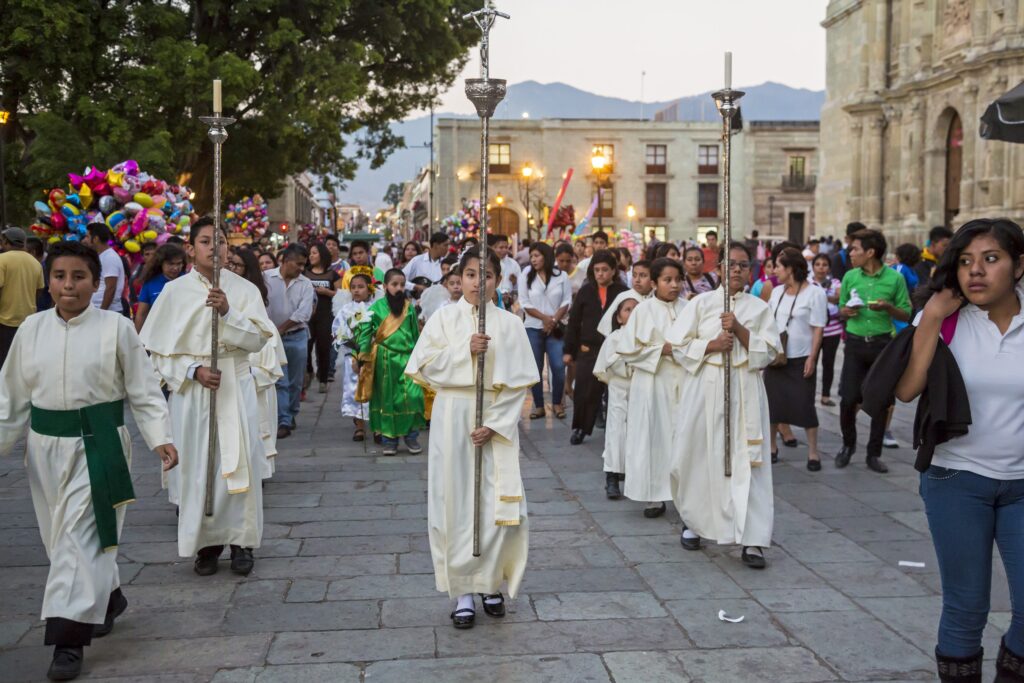This celebration is marked by two biblical events, which are the presentation of the baby Jesus in the temple and the purification of the Virgin Mary

One of the most important celebrations in the United States, as well as in countries such as Argentina, Bolivia, Chile, Colombia, Cuba, Mexico, Peru, or the Canary Islands, is Candlemas Day, also known as the Festival of Light, Festival of Candles or Presentation of the Lord, a name that comes from a candle, from “the light that guides the path.”
This celebration is marked by two biblical events, which are the presentation of the baby Jesus in the temple and the purification of the Virgin Mary, exactly 40 days after giving birth and after completing her quarantine, since according to Jewish tradition, the mothers had to wait 40 days after giving birth to purify themselves and present the baby to the religious authorities.
Joseph and Mary took Jesus to the temple in Jerusalem and upon entering the temple, Simeon, moved by the Holy Spirit, took Jesus in his arms and blessed him saying “now, Lord, according to your promise, you can let your servant go in peace , because my eyes have seen your savior, whom you have presented to all peoples; light to enlighten the nations and glory to your people, Israel.”
At that time, doves were brought as part of the celebration, but as time went by, they changed into candles.
In the United States, the Feast of the Presentation of Jesus Christ is celebrated on February 2, a date that also coincides with Groundhog Day, one of the most popular holidays in the country, when Phil the groundhog is expected to come out of his burrow, located in the municipality of Punxsutawney, Pennsylvania, to predict when winter will end.
Celebrations in Latin America
This tradition came to Latin America with the Spanish when the evangelizing friars indoctrinated the indigenous people.
The dedication to the Virgin of Candelaria or Our Lady of Candelaria, patron saint of the Canary Islands and which is celebrated on February 2, had its origin in these islands with the appearance of the Virgin in 1392, when some shepherds spotted a wooden image in the shape of a woman, who was carrying a child lying on her right arm, and in her left hand a candle.
In Mexico, the date coincided with the beginning of the planting season, so the populations of that time would bless the corn every February 2, and then plant it in tribute to the God Tláloc to achieve a good harvest. The date also coincided with some special celebrations led by Tláloc and his sister Chalchiuhtlicue (water gods).
That is why Candlemas Day is celebrated there with tamales, since corn is a symbolic plant in Mexico and according to the Mayan book, “Popol Vuh”, it is the element that the Gods used to create men and give them life.
In Mexico there is a tradition, and that is that whoever finds the figure of the baby Jesus when breaking the traditional king’s cake on January 6, must then offer tamales for the Candlemas Day dinner on February 2. It is also a day when parishioners attend Mass and the baby Jesus is dressed, and then taken to Mass to be blessed.
In some areas of Argentina, it is celebrated with traditional dances and fireworks, while in other areas with candlelight processions. Our Lady of Buen Aire, which is a representation and derivation of the Virgin of Candelaria or Our Lady of Candelaria, but with a different name, is the patron saint of the city of Buenos Aires.
In the city of Copacabana, in Bolivia, the Virgin of Copacabana is their patron, a representation of Virgin of Candelaria or Our Lady of Candelaria, which was carved by Francisco “Tito” Yupanqui and taken to that town on February 2, 1583. She is also patroness of other municipalities such as Coroico in La Paz, Aiquile in Cochabamba, Rurrenabaque in Beni, Samaipata in Santa Cruz, and La Angostura in Tarija. According to each area, Candlemas Day is celebrated on February 2 with special Masses, processions, musical groups, as well as typical dances and cheese and apple fairs.
On Mancera Island in Valdivia, Chile, there has been a great devotion to the Virgin of Candelaria or Our Lady of Candelaria since 1645. It was discovered by Mariano Caro Inca in the vicinity of the city of Copiapó, where there is a sanctuary to the Virgin of Candelaria, while in the town of Mincha there has been a temple and a national historical monument since 1980. It is also venerated in mining areas. On February 2, the Virgin of Candelaria or Our Lady of Candelaria is celebrated with Masses, processions, music, and prayers.
The Virgin of Candelaria is the patron saint of the cities of Medellín and Cartagena de Indias, in Colombia, as well as of the municipality of Magangué and the municipalities of Guame in Antioquia, of Arjona in Bolívar, of Santo Domingo de Silos in Norte de Santander, as well as Chita, Garagoa and La Capilla in Boyacá.
In the city of Camagüey and in the town of San Fernando de Camarones, in Cuba, the Virgin of Candelaria or Our Lady of Candelaria is the patron saint, and both there and in the cities of Morón and Consolación del Sur, Pinar del Rio, traditional processions are held.
While in Peru, the Day of Candelaria or Festival of the Virgin of Candelaria of Puno is one of the largest celebrations and was named Intangible Cultural Heritage of Humanity by UNESCO. This festival, as in other areas of Peru, includes plays, venerations, prayers, dances, processions, and special Masses.
Countries such as Brazil, Costa Rica, Ecuador, El Salvador, Guatemala, Honduras, Nicaragua, Paraguay, Puerto Rico, Uruguay, and Venezuela also celebrate Candlemas Day, also known as the Festival of Light, Festival of Candles, or Presentation of the Lord.
02:00
On the morning of December 24, Cardinal Dolan arrived at NYPD Precinct 13 to celebrate an early Christmas Mass for those who would later protect and serve on the streets during Midnight Mass.
By:
Patrick Grady
| 12/29/2025
"If Our Savior can be born in a stinky, messy place like that, He can certainly be reborn within us," the cardinal said in his homily.
By:
Steven Schwankert
| 12/29/2025
Three cardinals mark the conclusion of local Jubilee celebrations at Rome's major basilicas.
By:
OSV News
| 12/29/2025
Error, group does not exist! Check your syntax! (ID: 7)


